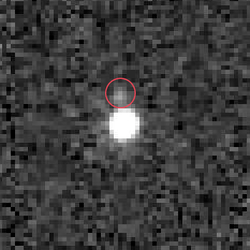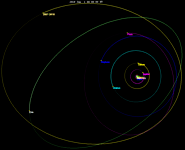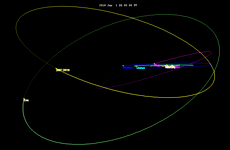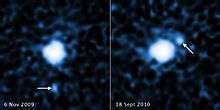(225088) 2007 OR10
 2007 OR10 and its moon seen by the Hubble Space Telescope in 2010 | |
| Discovery [1][2] | |
|---|---|
| Discovered by |
M. E. Schwamb M. E. Brown D. L. Rabinowitz |
| Discovery site | Palomar Obs. |
| Discovery date | 17 July 2007 [lower-alpha 1] |
| Designations | |
| MPC designation | (225088) 2007 OR10 |
| 2007 OR10 | |
|
TNO [3] · SDO [4] 3:10 res.[5][6] · p-DP [7] | |
| Orbital characteristics [3] | |
| Epoch 16 February 2017 (JD 2457800.5) | |
| Uncertainty parameter 4 | |
| Observation arc | 30.09 yr (10,989 days) |
| Earliest precovery date | 19 August 1985 |
| Aphelion | 101.02 AU |
| Perihelion | 33.102 AU |
| 67.059 AU | |
| Eccentricity | 0.5064 |
| 549.16 yr (200,579 days) | |
| 104.43° | |
| 0° 0m 6.48s / day | |
| Inclination | 30.904° |
| 336.82° | |
| 207.04° | |
| Known satellites | 1[8] (300 km[6]) |
| Physical characteristics | |
Mean diameter |
1253±43 km 1535+75 −225 km (assuming equator-on view)[9][10][11] 1280±210 km[12] |
| Mass | 1.75×1021 kg[9] |
Mean density | 1.72±0.16 g/cm3[9] |
| 44.81±0.37 h or 22.40±0.18 h (ambiguous) [10][11] | |
|
0.185+0.076 −0.052[12] 0.089+0.031 −0.009 (assuming equator-on view)[10][11] | |
| red[13] | |
| 21.4[14] | |
| 1.8[1][3] · 2.34[10] | |
|
| |
(225088) 2007 OR10 is a binary trans-Neptunian object orbiting the Sun in the scattered disc, approximately 1,250 kilometers (780 miles) in diameter. It is the fifth-largest known body in the Solar System beyond the orbit of Neptune,[9][10][11][15] and is the largest known body in the Solar System without a name.[16] According to estimates as of September 2018, it is slightly larger than Charon, and is hence almost certainly a dwarf planet.[7][6] It has one known moon, which is probably less than 100 kilometers (62 miles) in diameter.[9][6][8]
History
Discovery
(225088) 2007 OR10 was discovered on 17 July 2007, American astronomers Megan Schwamb, Michael Brown and David Rabinowitz at Palomar Observatory in California.[1] It was part of the PhD thesis of Megan Schwamb, then a graduate student of Michael Brown at CalTech.[17]
Naming
Brown nicknamed the object "Snow White" for its presumed white color,[17] because it would have to be very large or very bright to be detected by their survey.[16] By that time, Brown's team had already discovered "seven dwarves": Quaoar in 2002, Sedna in 2003, Haumea, Salacia and Orcus in 2004, and Makemake and Eris in 2005. However, 2007 OR10 turned out to be one of the reddest objects in the Kuiper belt, comparable only to Quaoar, so the nickname was dropped.
2007 OR10 is currently the largest known object in the Solar System without an official name. In 2011 Brown decided he finally had enough information to justify giving it one, because the discovery of water ice and the possibility of methane makes it noteworthy enough to warrant further study.[17] However, as of 2017, Brown had yet to propose a name, though he notes that in November 2019 anyone will be able to make a proposal.[18]
Distance
(225088) 2007 OR10 came to perihelion of 33 AUs around 1857.[3] As of March 2018 it is located 87.9 AUs from the Sun[19] and moving away from the Sun at 1.1 kilometers per second (2,500 miles per hour).[20] This makes it the fifth-farthest known large body in the Solar System, after Eris (96.3 AU), V774104 (<96 AU?), 2014 UZ224 (91.4 AU), 2015 TH367 (89.2 AU), and farther out than Sedna (85.7 AU) as of 4 February 2017.[16] It has been farther from the Sun than Sedna since 2013.[20] 2007 OR10 will be farther than both Sedna and Eris by 2045,[21] and it will reach aphelion in 2130.[20]
| Most-distant known objects in the Solar System as of 2 October 2018[19] | ||||||||||||||||||||||||||||||||||||||||||||||||||||||||||||||||||||||||||||||||||||||||||||||||||
|---|---|---|---|---|---|---|---|---|---|---|---|---|---|---|---|---|---|---|---|---|---|---|---|---|---|---|---|---|---|---|---|---|---|---|---|---|---|---|---|---|---|---|---|---|---|---|---|---|---|---|---|---|---|---|---|---|---|---|---|---|---|---|---|---|---|---|---|---|---|---|---|---|---|---|---|---|---|---|---|---|---|---|---|---|---|---|---|---|---|---|---|---|---|---|---|---|---|---|
| Object name | Distance from the Sun (AU) | Apparent magnitude |
Absolute magnitude (H) | |||||||||||||||||||||||||||||||||||||||||||||||||||||||||||||||||||||||||||||||||||||||||||||||
| Current | Perihelion | Aphelion | ||||||||||||||||||||||||||||||||||||||||||||||||||||||||||||||||||||||||||||||||||||||||||||||||
| V774104 | 103? | Unknown | Unknown | 24 | 4 | |||||||||||||||||||||||||||||||||||||||||||||||||||||||||||||||||||||||||||||||||||||||||||||
| Eris | 96.10 | 37.8 | 97.6 | 18.7 | −1.1 | |||||||||||||||||||||||||||||||||||||||||||||||||||||||||||||||||||||||||||||||||||||||||||||
| 2014 UZ224 | 90.70 | 38.0 | 179.8 | 23.2 | 3.5 | |||||||||||||||||||||||||||||||||||||||||||||||||||||||||||||||||||||||||||||||||||||||||||||
| 2015 TH367 | 89.32 | 28.6 | 139.7 | 26.2 | 6.6 | |||||||||||||||||||||||||||||||||||||||||||||||||||||||||||||||||||||||||||||||||||||||||||||
| 2007 OR10 | 88.08 | 33.0 | 100.8 | 21.7 | 1.8 | |||||||||||||||||||||||||||||||||||||||||||||||||||||||||||||||||||||||||||||||||||||||||||||
| Sedna | 85.00 | 76.0 | 939 | 21.0 | 1.5 | |||||||||||||||||||||||||||||||||||||||||||||||||||||||||||||||||||||||||||||||||||||||||||||
| 2014 FC69 | 84.87 | 40.3 | 106.9 | 24.1 | 4.6 | |||||||||||||||||||||||||||||||||||||||||||||||||||||||||||||||||||||||||||||||||||||||||||||
| 2013 FS28 | 84.55 | 34.6 | 347.6 | 24.5 | 4.9 | |||||||||||||||||||||||||||||||||||||||||||||||||||||||||||||||||||||||||||||||||||||||||||||
| 2006 QH181 | 83.98 | 37.8 | 96.7 | 23.6 | 4.3 | |||||||||||||||||||||||||||||||||||||||||||||||||||||||||||||||||||||||||||||||||||||||||||||
| 2012 VP113 | 83.72 | 80.5 | 438 | 23.4 | 4.0 | |||||||||||||||||||||||||||||||||||||||||||||||||||||||||||||||||||||||||||||||||||||||||||||
| 2015 VO166 | 83.44 | 38.2 | 113 | 25.2 | 5.9 | |||||||||||||||||||||||||||||||||||||||||||||||||||||||||||||||||||||||||||||||||||||||||||||
| 2015 UH87 | 81.80 | 34.7 | 90.1 | 25.3 | 6.0 | |||||||||||||||||||||||||||||||||||||||||||||||||||||||||||||||||||||||||||||||||||||||||||||
| 2013 FY27 | 80.02 | 36.1 | 81.8 | 22.1 | 3.0 | |||||||||||||||||||||||||||||||||||||||||||||||||||||||||||||||||||||||||||||||||||||||||||||
| 2015 TG387 | 78.65 | 64.9 | 2120 | 24.3 | 5.3 | |||||||||||||||||||||||||||||||||||||||||||||||||||||||||||||||||||||||||||||||||||||||||||||
| 2017 FO161 | 78.57 | 33.1 | 93.9 | 24.2 | 5.2 | |||||||||||||||||||||||||||||||||||||||||||||||||||||||||||||||||||||||||||||||||||||||||||||
| 2015 TJ367 | 78.25 | 33.5 | 127.5 | 25.7 | 6.7 | |||||||||||||||||||||||||||||||||||||||||||||||||||||||||||||||||||||||||||||||||||||||||||||
| 2015 VJ168 | 72.90 | 37.4 | 81.3 | 24.6 | 5.8 | |||||||||||||||||||||||||||||||||||||||||||||||||||||||||||||||||||||||||||||||||||||||||||||
| 2010 GB174 | 72.16 | 48.7 | 693 | 25.1 | 6.5 | |||||||||||||||||||||||||||||||||||||||||||||||||||||||||||||||||||||||||||||||||||||||||||||
| 2015 GN55 | 71.56 | 32.7 | 78.4 | 24.5 | 5.8 | |||||||||||||||||||||||||||||||||||||||||||||||||||||||||||||||||||||||||||||||||||||||||||||
| 2014 FJ72 | 71.41 | 38.7 | 152.2 | 24.2 | 5.6 | |||||||||||||||||||||||||||||||||||||||||||||||||||||||||||||||||||||||||||||||||||||||||||||
| 2016 TS97 | 71.36 | 36.2 | 71.6 | 24.8 | 6.1 | |||||||||||||||||||||||||||||||||||||||||||||||||||||||||||||||||||||||||||||||||||||||||||||
| 2015 VL168 | 70.86 | 37.6 | 136 | 25.3 | 6.1 | |||||||||||||||||||||||||||||||||||||||||||||||||||||||||||||||||||||||||||||||||||||||||||||
| 2012 FH84 | 68.80 | 45.8 | 80.6 | 25.7 | 7.3 | |||||||||||||||||||||||||||||||||||||||||||||||||||||||||||||||||||||||||||||||||||||||||||||
| 2015 RZ277 | 68.45 | 34.3 | 90.0 | 25.5 | 6.8 | |||||||||||||||||||||||||||||||||||||||||||||||||||||||||||||||||||||||||||||||||||||||||||||
| 2015 GR50 | 68.41 | 35.6 | 78.6 | 25.1 | 6.7 | |||||||||||||||||||||||||||||||||||||||||||||||||||||||||||||||||||||||||||||||||||||||||||||
| 2015 GP50 | 67.87 | 40.3 | 70.3 | 24.8 | 6.5 | |||||||||||||||||||||||||||||||||||||||||||||||||||||||||||||||||||||||||||||||||||||||||||||
| 2013 FQ28 | 67.86 | 48.7 | 80.6 | 24.4 | 6.0 | |||||||||||||||||||||||||||||||||||||||||||||||||||||||||||||||||||||||||||||||||||||||||||||
| 2016 CD289 | 66.66 | 36.8 | 75.3 | 25.6 | 7.3 | |||||||||||||||||||||||||||||||||||||||||||||||||||||||||||||||||||||||||||||||||||||||||||||
| 2014 UD228 | 66.23 | 36.4 | 73.0 | 24.4 | 6.1 | |||||||||||||||||||||||||||||||||||||||||||||||||||||||||||||||||||||||||||||||||||||||||||||
| 2015 KV167 | 65.16 | 38.2 | 65.3 | 25.4 | 7.2 | |||||||||||||||||||||||||||||||||||||||||||||||||||||||||||||||||||||||||||||||||||||||||||||
| 2013 UJ15 | 65.06 | 36.3 | 69.2 | 25.2 | 7.0 | |||||||||||||||||||||||||||||||||||||||||||||||||||||||||||||||||||||||||||||||||||||||||||||
| 2014 FL72 | 64.69 | 38.2 | 170.4 | 25.0 | 6.8 | |||||||||||||||||||||||||||||||||||||||||||||||||||||||||||||||||||||||||||||||||||||||||||||
| 2014 FD70 | 64.51 | 38.6 | 69.3 | 25.0 | 6.9 | |||||||||||||||||||||||||||||||||||||||||||||||||||||||||||||||||||||||||||||||||||||||||||||
| 2015 KG172 | 64.05 | 42.1 | 68.7 | 24.1 | 6.0 | |||||||||||||||||||||||||||||||||||||||||||||||||||||||||||||||||||||||||||||||||||||||||||||
| 2014 SU349 | 63.50 | 30.8 | 109.8 | 25.0 | 7.0 | |||||||||||||||||||||||||||||||||||||||||||||||||||||||||||||||||||||||||||||||||||||||||||||
| 2015 RL258 | 63.35 | 34.7 | 67.8 | 24.7 | 6.5 | |||||||||||||||||||||||||||||||||||||||||||||||||||||||||||||||||||||||||||||||||||||||||||||
| 2015 KF172 | 63.23 | 38.2 | 102.8 | 23.6 | 5.5 | |||||||||||||||||||||||||||||||||||||||||||||||||||||||||||||||||||||||||||||||||||||||||||||
| 2015 RR245 | 63.02 | 33.7 | 129.2 | 22.1 | 3.9 | |||||||||||||||||||||||||||||||||||||||||||||||||||||||||||||||||||||||||||||||||||||||||||||
| 2011 GM89 | 62.87 | 37.2 | 68.8 | 25.6 | 7.1 | |||||||||||||||||||||||||||||||||||||||||||||||||||||||||||||||||||||||||||||||||||||||||||||
| 2013 AT183 | 62.77 | 36.0 | 88.1 | 22.0 | 4.7 | |||||||||||||||||||||||||||||||||||||||||||||||||||||||||||||||||||||||||||||||||||||||||||||
| 2014 FE72 | 62.47 | 36.3 | 4274.0 | 24.1 | 6.1 | |||||||||||||||||||||||||||||||||||||||||||||||||||||||||||||||||||||||||||||||||||||||||||||
| 2017 DO121 | 62.00 | 26.7 | 185.6 | 25.6 | 7.6 | |||||||||||||||||||||||||||||||||||||||||||||||||||||||||||||||||||||||||||||||||||||||||||||
| 2000 CR105 | 61.85 | 44.3 | 412 | 23.9 | 6.3 | |||||||||||||||||||||||||||||||||||||||||||||||||||||||||||||||||||||||||||||||||||||||||||||
| 2015 VG157 | 61.79 | 39.0 | 68.5 | 25.5 | 7.5 | |||||||||||||||||||||||||||||||||||||||||||||||||||||||||||||||||||||||||||||||||||||||||||||
| 2014 SV349 | 61.57 | 34.2 | 89.0 | 23.0 | 5.0 | |||||||||||||||||||||||||||||||||||||||||||||||||||||||||||||||||||||||||||||||||||||||||||||
| 2008 ST291 | 60.96 | 42.4 | 154.5 | 22.2 | 4.2 | |||||||||||||||||||||||||||||||||||||||||||||||||||||||||||||||||||||||||||||||||||||||||||||
| 2015 RX245 | 60.76 | 45.5 | 768.9 | 24.2 | 6.2 | |||||||||||||||||||||||||||||||||||||||||||||||||||||||||||||||||||||||||||||||||||||||||||||
| 2014 FM72 | 60.55 | 34.4 | 76.6 | 24.1 | 6.2 | |||||||||||||||||||||||||||||||||||||||||||||||||||||||||||||||||||||||||||||||||||||||||||||
| 2017 DP121 | 60.33 | 40.5 | 60.4 | 25.1 | 7.2 | |||||||||||||||||||||||||||||||||||||||||||||||||||||||||||||||||||||||||||||||||||||||||||||
| 2014 FF72 | 60.25 | 37.1 | 63.3 | 24.8 | 6.9 | |||||||||||||||||||||||||||||||||||||||||||||||||||||||||||||||||||||||||||||||||||||||||||||
| 2003 QX113 | 60.16 | 36.7 | 62.1 | 22.5 | 4.7 | |||||||||||||||||||||||||||||||||||||||||||||||||||||||||||||||||||||||||||||||||||||||||||||
| 2015 KH162 | 59.76 | 41.5 | 82.8 | 21.6 | 3.9 | |||||||||||||||||||||||||||||||||||||||||||||||||||||||||||||||||||||||||||||||||||||||||||||
| 2015 FU403 | 59.75 | 34.0 | 88.4 | 25.3 | 7.5 | |||||||||||||||||||||||||||||||||||||||||||||||||||||||||||||||||||||||||||||||||||||||||||||
| 2015 GW55 | 59.65 | 34.0 | 137.6 | 24.5 | 6.7 | |||||||||||||||||||||||||||||||||||||||||||||||||||||||||||||||||||||||||||||||||||||||||||||
| 2013 JQ64 | 59.40 | 22.6 | 76.0 | 24.4 | 6.2 | |||||||||||||||||||||||||||||||||||||||||||||||||||||||||||||||||||||||||||||||||||||||||||||
| 2015 RK258 | 59.03 | 35.8 | 111.8 | 24.9 | 7.1 | |||||||||||||||||||||||||||||||||||||||||||||||||||||||||||||||||||||||||||||||||||||||||||||
| This table includes all known objects currently located at least twice as far as Neptune.[19] See List of trans-Neptunian objects for more. | ||||||||||||||||||||||||||||||||||||||||||||||||||||||||||||||||||||||||||||||||||||||||||||||||||
Absolute magnitude
The size of an object can be calculated from its absolute magnitude (H) and the albedo (the amount of light it reflects). 2007 OR10 has an absolute magnitude (H) of 1.8,[3] which makes it the sixth-brightest TNO known,[22] a little less bright than Sedna (H=1.5; D≈1,000 km)[23] and brighter than Orcus (H=2.2; D≈900 km).[24]
2007 OR10 is among the reddest objects known. This is probably in part due to methane frosts, which turn red when bombarded by sunlight and cosmic rays.[13]
Surface composition and atmosphere
The spectrum of 2007 OR10 shows signatures for both water ice and methane, which makes it similar in composition to Quaoar. The presence of red methane frost on the surfaces of both 2007 OR10 and Quaoar implies the existence of a tenuous methane atmosphere on both objects, slowly evaporating into space. Although 2007 OR10 comes closer to the Sun than Quaoar, and is thus warm enough that a methane atmosphere should evaporate, its larger mass makes retention of an atmosphere just possible.[13] In particular, 2007 OR10's large size means that it is likely to retain even nitrogen, which almost all TNOs lose over the course of their existence.[25] The presence of water ice on the surface of 2007 OR10 implies a brief period of cryovolcanism in its distant past.[26]
Orbit
The Deep Ecliptic Survey (DES) shows the orbit to be in a 3:10 resonance with Neptune.[5] The MPC lists it as a scattered-disc object.[4] 2007 OR10 was discovered when searching for objects in the region of Sedna.[27]
2007 OR10 has been observed 230 times over 13 oppositions with a precovery image from 19 August 1985.[3]
It was formally announced on 7 January 2009.[2]



Dwarf-planet status
Based on the most recent size estimates as of 2018,[9] 2007 OR10 would be the fifth-largest dwarf planet, after Pluto, Eris, Haumea, and Makemake, and before Ceres. The IAU has not addressed the possibility of accepting additional dwarf planets since before the discovery of 2007 OR10 was announced. Brown states that it "must be a dwarf planet even if predominantly rocky",[7] and Scott Sheppard and colleagues think that it is "likely" to be a dwarf planet,[28] based on its minimum possible diameter (552 km)[29] and what is understood of the conditions for hydrostatic equilibrium in cold icy–rocky bodies. 2007 OR10 is too distant for its diameter to be resolved directly; Brown's estimate of 1,000–1,500 km is based on calculating the albedo that is the best fit in his model,[13] which agrees with the 1280±210 km determined from observations by the Herschel space observatory.[12] Based on the orbit of 2007 OR10's small satellite (see below), its mass has been calculated to be 1.75×1021 kg, for a density of 1.72±0.16 g/cm3.[9] Mass and density are also factors in hydrostatic equilibrium.
An earlier size estimate of 1535+75
−225 km[10][11] was based on an assumed equator-on view. Given the mass of 1.75×1021 kg, this size would imply a density of 0.92+0.46
−0.12 g/cm3, unexpectedly low for an object of that size. Kiss et al. estimate that 2007 OR10 is between 1,210 and 1,295 km in diameter.[9]
Satellite

The slow rotation rate of 2007 OR10, compared to the other TNOs, raised the possibility of a satellite that slowed down the rotation via tidal dissipation. In 2016, analysis of Hubble images of 2007 OR10 taken in 2010 revealed a satellite orbiting at a distance of at least 15,000 km. Assuming that satellite and primary had equal albedos, the satellite was initially estimated to be around 300 km in diameter. It was announced at the DPS48 meeting on 17 October 2016.[8][31] The satellite is probably too small and dark to affect size estimates for 2007 OR10.[8] Further analysis from May 2017 confirmed this orbiting moon.[32][33]
Based on Hubble observations taken between October and December 2017,[34] the orbit and physical properties of the satellite could be further constrained. The orbit has a relatively high eccentricity of 0.31, either resulting from an intrinsically eccentric orbit and slow tidal evolution, or caused by the Kozai mechanism. The dynamics of the orbit suggest that the satellite is small, less than 100 kilometres (62 mi) in diameter, indicating an albedo much higher than that of 2007 OR10. The satellite is far less red than 2007 OR10. The colour difference of ΔV-R=0.43±0.17 mag between primary and satellite is the largest among all known binary transneptunian objects.[9]
See also
Notes
- ↑ Discovery was announced two years later on 7 January 2009
References
- 1 2 3 "225088 (2007 OR10)". Minor Planet Center. Retrieved 5 March 2018.
- 1 2 "MPEC 2009-A42 : 2007 OR10". Minor Planet Center. 7 January 2009.
- 1 2 3 4 5 6 "JPL Small-Body Database Browser: 225088 (2007 OR10)" (2015-09-20 last obs.). Jet Propulsion Laboratory. Retrieved 28 February 2017.
- 1 2 "List Of Centaurs and Scattered-Disk Objects". Minor Planet Center. Retrieved 9 February 2018.
- 1 2 3 Buie, M. (24 October 2011). "Orbit Fit and Astrometric record for 225088". SwRI (Space Science Department). Retrieved 14 November 2014.
- 1 2 3 4 Johnston, Wm. Robert (30 December 2017). "List of Known Trans-Neptunian Objects". Johnston's Archive. Retrieved 9 February 2018.
- 1 2 3 Brown, Michael E. "How many dwarf planets are there in the outer solar system?". California Institute of Technology. Retrieved 9 February 2018.
- 1 2 3 4 Lakdawalla, E. (19 October 2016). "DPS/EPSC update: 2007 OR10 has a moon!". The Planetary Society. Retrieved 2016-10-19.
- 1 2 3 4 5 6 7 8 9 Kiss, C.; Marton, G.; Parker, A.; Grundy, W.; Farkas-Takács, A. I.; Stansberry, J.; Pal, A.; Müller, T. G.; Noll, K.; Schwamb, M. E.; Barr Mlinar, A. C.; Young, L. A.; Vinkó, J. (24 October 2018). The mass and density of the dwarf planet 2007 OR10. 50th annual meeting of the AAS Division of Planetary Sciences. abstract 311.02. Retrieved 21 September 2018.
- 1 2 3 4 5 6 Pál, András; Kiss, Csaba; Müller, Thomas G.; Molnár, László; Szabó, Róbert; Szabó, Gyula M.; et al. (May 2016). "Large Size and Slow Rotation of the Trans-Neptunian Object (225088) 2007 OR10 Discovered from Herschel and K2 Observations" (PDF). The Astronomical Journal. 151 (5): 8. arXiv:1603.03090. Bibcode:2016AJ....151..117P. doi:10.3847/0004-6256/151/5/117. Retrieved 5 March 2018.
- 1 2 3 4 5 Szabó, Róbert (4 November 2015). "Pushing the Limits of K2:Observing Trans-Neptunian Objects S3K2: Solar System Studies with K2" (PDF). Retrieved 19 January 2018.
- 1 2 3 Santos-Sanz, P.; et al. (2012). ""TNOs are Cool": A survey of the trans-Neptunian region. IV. Size/albedo characterization of 15 scattered disk and detached objects observed with Herschel-PACS". Astronomy & Astrophysics. 541: A92. arXiv:1202.1481. Bibcode:2012A&A...541A..92S. doi:10.1051/0004-6361/201118541.
- 1 2 3 4 Brown, M. E.; Burgasser, A. J.; Fraser, W. C. (September 2011). "The Surface Composition of Large Kuiper Belt Object 2007 OR10" (PDF). The Astrophysical Journal Letters. 738 (2): 4. arXiv:1108.1418. Bibcode:2011ApJ...738L..26B. doi:10.1088/2041-8205/738/2/L26. Retrieved 5 March 2018.
- ↑ "AstDys 2007OR10 Ephemerides". Department of Mathematics, University of Pisa, Italy. Archived from the original on 17 May 2009. Retrieved 16 March 2009.
- ↑ Dyches, P. (2016-05-11). "2007 OR10: Largest Unnamed World in the Solar System". Jet Propulsion Lab. Retrieved 2016-05-12.
- 1 2 3 Michael E. Brown (10 March 2009). "Snow White needs a bailout". Archived from the original on 17 May 2009. Retrieved 17 February 2010.
- 1 2 3 "Astronomers Find Ice and Possibly Methane On Snow White, a Distant Dwarf Planet". Science Daily. 22 August 2011. Retrieved 5 March 2018.
- ↑ Brown, Mike. "Mike Brown on Twitter". Twitter. Retrieved 11 April 2017.
- 1 2 3 "AstDyS-2, Asteroids - Dynamic Site". Retrieved 2018-04-03.
Objects with distance from Sun over 59 AU
- 1 2 3 "Horizon Online Ephemeris System". Jet Propulsion Laboratory. Retrieved 31 January 2012.
- ↑ "Horizons Output for Sedna 2076/2114". JPL Horizons On-Line Ephemeris System. 17 February 2011. Archived from the original on 25 February 2012. Retrieved 17 February 2011.
- ↑ Brown, Mike Brown (11 August 2011). "The Redemption of Snow White (Part 2 of 3)". Mike Brown's Planets. Archived from the original on 25 July 2014.
- ↑ "JPL Small-Body Database Browser: 90377 Sedna (2003 VB12)" (2008-10-23 last obs). Retrieved 21 January 2009.
- ↑ "JPL Small-Body Database Browser: 90482 Orcus (2004 DW)" (2008-12-04 last obs). Retrieved 5 February 2009.
- ↑ "2007 OR10: Largest Unnamed World in the Solar System". nasa.gov.
- ↑ Brown, Mike (20 August 2011). "The Redemption of Snow White (Part 3 of 3)". Mike Brown's Planets. Archived from the original on 25 July 2014.
- ↑ Schwamb, Megan E.; Brown, Michael E.; Rabinowitz, David L. (2009). "A Search for Distant Solar System Bodies in the Region of Sedna". Astrophysical Journal Letters. 694: L45. arXiv:0901.4173. Bibcode:2009ApJ...694L..45S. doi:10.1088/0004-637X/694/1/L45.
- ↑ Sheppard, Scott S.; Udalski, Andrzej; Trujillo, Chadwick; Kubiak, Marcin; Pietrzynski, Grzegorz; Poleski, Radoslaw; et al. (October 2011). "A Southern Sky and Galactic Plane Survey for Bright Kuiper Belt Objects". The Astronomical Journal. 142 (4): 10. arXiv:1107.5309. Bibcode:2011AJ....142...98S. doi:10.1088/0004-6256/142/4/98. Retrieved 11 December 2017.
- ↑ 1329×10(−H/5)
- ↑ "Moon Around the Dwarf Planet 2007 OR10". www.spacetelescope.org. Retrieved 22 May 2017.
- ↑ "The moon of the large Kuiper-belt object 2007 OR10" (PDF). DPS48 120.22. Retrieved 17 October 2016.
- ↑ "Moon orbits third largest dwarf planet in our solar system". Science Daily. 18 May 2017. Retrieved 19 May 2017.
- ↑ Kiss, C.; et al. (2017). "Discovery of a Satellite of the Large Trans-Neptunian Object (225088) 2007 OR10". The Astrophysical Journal Letters. 838 (1). L1.
- ↑ Parker, Alex (7 April 2017). "The Moons of Kuiper Belt Dwarf Planets Makemake and 2007 OR10 HST Proposal 15207". STScI. Retrieved 21 September 2018.
External links
| Wikimedia Commons has media related to (225088) 2007 OR10. |
- 2007 OR10 Precovery Images
- 2007 OR10 Minor planet designation number
- The redemption of Snow White (Part 1) (Mike Brown blog 9 August 2011)
- Discovery Circumstances: Numbered Minor Planets (225001)-(230000) – Minor Planet Center
- Give Dwarf Planet 2007 OR10 the Real Name It Deserves Already 5/12/16
- (225088) 2007 OR10 at the JPL Small-Body Database


_(cropped).jpg)
